![]()
![]()
![]()
Use LEFT and RIGHT arrow keys to navigate between flashcards;
Use UP and DOWN arrow keys to flip the card;
H to show hint;
A reads text to speech;
21 Cards in this Set
- Front
- Back
|
What does the presence of coliform bacteria in water indicate?
|
This indicates that the water has been contaminated by fecal matter.
|
|
|
Where is coliform bacteria from?
|
Animal intestines or colon
|
|
|
What does MPN stand for?
|
most probable number
|
|
|
Identify the formula for the MPN of coliform bacteria in a given sample.
|

|
|
|
Solve the problem.
You have 100 colonies present on your petri dish. You filtered 100 mL of water for the experiment. Calculate the MPN. |

|
|
|
Solve the problem.
You have 100 colonies present on your petri dish. You have filtered 200 mL of water for the experiment. Calculate the MPN. |
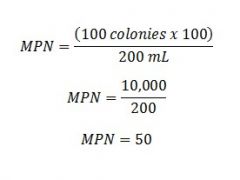
|
|
|
Briefly describe the process of the membrane filtration technique.
|
Water samples are run through a 0.45 μm filter.
Any bacteria that are present will be trapped in the filter. |
|
|
Identify the 2 methods in the water microbiology lab to test for coliform bacteria.
|
Membrane filtration technique
Multiple tube technique |
|
|
Briefly describe the process of the multiple tube technique.
|
Water samples are placed into tubes containing lactose and Durham tubes.
Coliform bacteria will ferment lactose producing acid & gas. Durham tubes detect the presence of gas formation, therefore detecting coliform bacteria. |
|
|
Identify how Durham tubes function in the multiple tube technique.
|
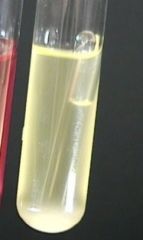
Durham tubes detect the presence of gas formation.
Coliform bacteria ferment lactose, thus producing acid & gas as a byproduct. |
|
|
What is the presumptive test of the multiple tube technique?
|
If gas is produced after the first week, we "presume" that coliforms are present.
|
|
|
What is the confirmed test of the multiple tube technique?
|
A sample is from one of the gas-producing tubes is streaked onto plates to detect bacterial growth.
If colonies grow, it confirms the presence of coliforms. |
|
|
What does it mean when an antibiotic has a "sensitivity" rating?
|
Antibiotic can be used medically
Antibiotic can kill the bacteria effectively *This is the highest rating |
|
|
What does it mean when an antibiotic has a "resistant" rating?
|
Antibiotic cannot be used medically
Antibiotic cannot kill the bacteria *This is the lowest rating |
|
|
What does it mean when an antibiotic has a "intermediate" rating?
|
Antibiotic still cannot be used medically
Antibiotic still cannot kill the bacteria *This is the middle rating |
|
|
Are Durham tubes placed in tubes right-side up or upside-down?
|
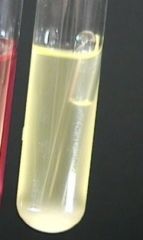
Upside-down
|
|
|
BACTERIAL CONJUGATION EXPERIMENT:
Did your actual results agree w/ your expected results? |
Yes
|
|
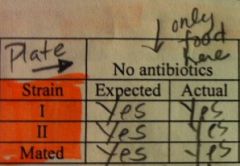
BACTERIAL CONJUGATION EXPERIMENT:
Explain the bacterial growth for each strain on this particular plate. |
This plate contained ONLY nutrients and NO antiobiotics. This is why Strain I, Strain II, and the Mated Strain all grew. Nothing was impeding growth.
|
|
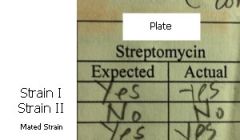
BACTERIAL CONJUGATION EXPERIMENT:
Explain the bacterial growth for each strain on this particular plate. |
Strain I grew because it has the streptomycin-resistant gene.
Strain II did not grow b/c it did not have the streptomycin-resistant gene. The Mated Strain grew because it has the streptomycin-resistant gene in addition to the ampicillin-resistant gene. |
|
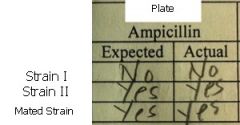
BACTERIAL CONJUGATION EXPERIMENT:
Explain the bacterial growth for each strain on this particular plate. |
Strain I did not grow b/c it did not have the ampicillin-resistant gene.
Strain II grew because it has the ampicillin-resistant gene. The Mated Strain grew because it has the ampicillin-resistant gene in addition to the streptomycin-resistant gene. |
|

BACTERIAL CONJUGATION EXPERIMENT:
Explain the bacterial growth for each strain on this particular plate. |
Strain I did not grow b/c it did not have the ampicillin-resistant gene and the ampicillin in the media killed the strain.
Strain II did not grow b/c it did not have the streptomycin-resistant gene and the streptomycin in the media killed the strain. The Mated Strain grew because it had the both the ampicillin-resistant gene & streptomycin-resistant gene. |

